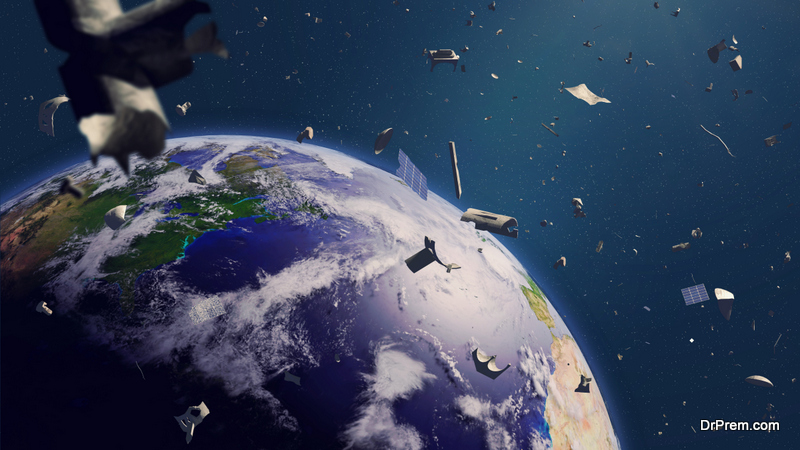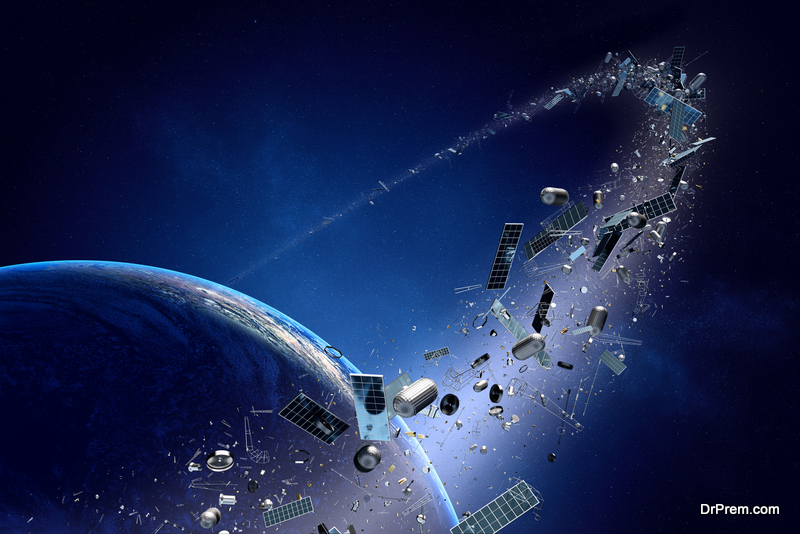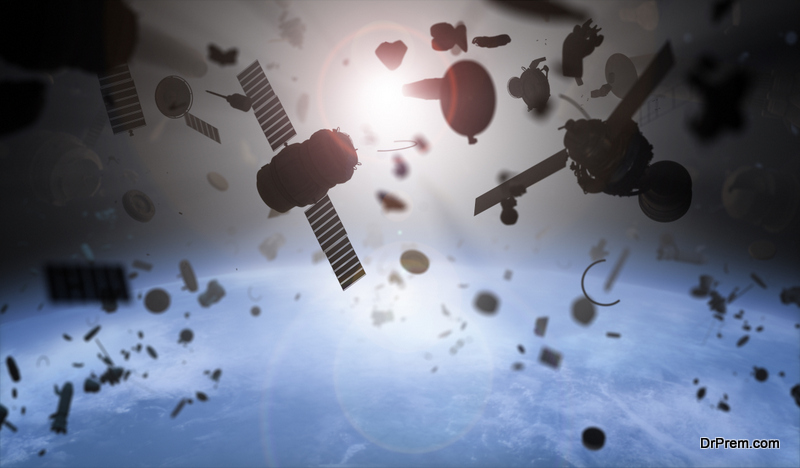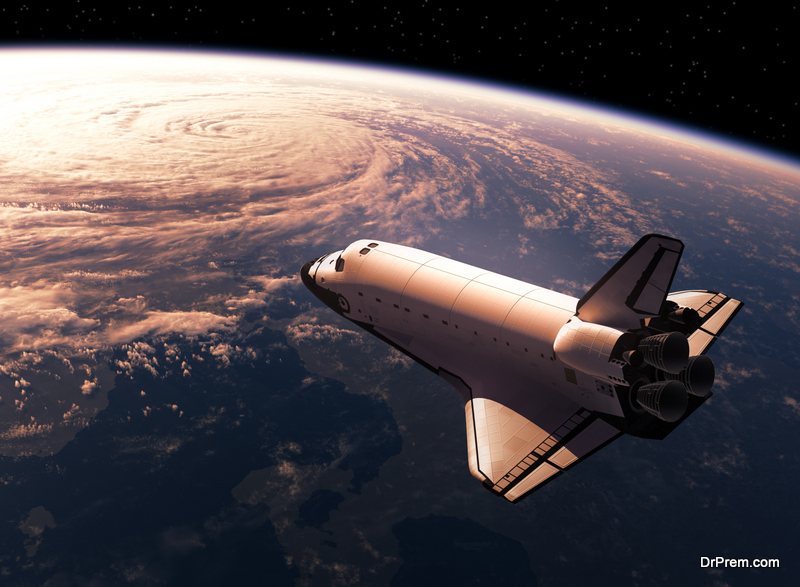The space above earth is filled with space junk from rockets and satellites. Space junk, or fragmented parts moving around in Earth’s orbit, totals almost a million chunks of debris. Space junk is an accumulation of old, defunct satellites and debris arising from collisions. It is a completely man made problem, which arose because of launching innumerable satellites in the quest of research, security and commercial ventures. It’s now a massive problem, and it’s getting bigger as companies and governments are launching satellites and microsatellites every day. Is there any solution to the space junk problem? Let’s find out!
The magnitude of the space junk problem
 There are approximately half a million pieces of debris bigger than the size of a marble floating above earth. Additionally, 20,000 pieces are bigger than the size of one softball are in the way of other satellites. This is just the tip of the iceberg – according to scientists, millions of tiny fragments are there in Earth’s orbit which cannot be seen, but can cause a lot of damage.
There are approximately half a million pieces of debris bigger than the size of a marble floating above earth. Additionally, 20,000 pieces are bigger than the size of one softball are in the way of other satellites. This is just the tip of the iceberg – according to scientists, millions of tiny fragments are there in Earth’s orbit which cannot be seen, but can cause a lot of damage.
Types of orbits above earth
There are three main orbits you’ll find above the Earth:
Low Earth Orbit – Remote sensing satellites are usually found orbiting here at a speed of 500-600 kms above ground.
Medium Earth Orbit- GPS satellites orbit here, 20,000 km above ground.
Geostationary or Geo Orbit – In this orbit, you’ll find communication satellites, 35,000 kms above ground.
Most of the space junk is derived from the orbiting satellites and rockets which had shot them up into space. Sudden collisions and gradual degradation of the rockets or satellites cause them to break down into miniscule fragments, which continue orbiting at speeds as high as thousands kms per hour, adding to the space junk problem.
Space debris, which were actually paint flecks, led to one of NASA’s shuttle’s windows being damaged to the extent that they had to be replaced. Scientists are suggesting that the huge amount of space junk will be the cause for multiple collisions, leading to the creation of bigger space junk problem. This could make an orbit completely redundant.
What causes space junk?
 Collisions are one of the major cause of space junk creation. The Kessler Syndrome – a form of space ‘sickness’ in which the low-Earth orbit is so filled up that collisions cascade or result into many more collisions. This has created the massive space junk problem, which might lead to the damage or destruction of other satellites, and even the manned International Space Station, endangering human lives. The 18th Space Control Squadron had to send 3,995,874 warnings last year, to various satellite owners to let them know that some space junk or some satellite was in their path and would probably collide.
Collisions are one of the major cause of space junk creation. The Kessler Syndrome – a form of space ‘sickness’ in which the low-Earth orbit is so filled up that collisions cascade or result into many more collisions. This has created the massive space junk problem, which might lead to the damage or destruction of other satellites, and even the manned International Space Station, endangering human lives. The 18th Space Control Squadron had to send 3,995,874 warnings last year, to various satellite owners to let them know that some space junk or some satellite was in their path and would probably collide.
Space junk has the capacity to exist in space for centuries
Satellites are supposed to last for about ten years, but they can last for much longer, which aggravates the space junk problem. The space trash returns back to Earth when it slows down enough to be pulled back by the drag of Earth. Some of the space junk might last for centuries in space. And some of this could have an effect on environment too.
Scientific inventions throughout human history have one thing in common – things are invented without considering the disposal when the articles are no longer in use. One of the most popular articles – which was manufactured without thought of disposal – plastic also lasts for centuries. Now, space junk is another severe pollution problem created by mankind in Earth’s orbit, because scientists either didn’t care about the rockets/satellites’ disposal after their work was done. This is how, bit by bit, the space junk problem came into being.
No one controls space
 There is no regulatory body in space – no country owns space. Many countries and private companies have sent numerous satellites without anyone stopping them, and ultimately littering space.
There is no regulatory body in space – no country owns space. Many countries and private companies have sent numerous satellites without anyone stopping them, and ultimately littering space.
Can collisions be avoided?
Orbital debris/satellites are monitored by NASA which then tries to move spacecraft out of the way of floating debris or shield against the space junk. But, it’s very hard to predict the path of a piece of space trash/junk. Gravitational anomalies, effect of Earth’s magnetic field as well as light from the Sun and Earth affect the path of space junk as well as satellites. Therefore, two orbiting objects can collide quite easily! To cite an example, the Iridium and Cosmos satellites collided in 2009, even though they were not expected to.
Steps to rectify the problem of space junk
 One of the first possible solutions of space problem was ‘parking’ the dead satellites and rockets in an orbit termed as ‘graveyard orbit’, which was far away from the geostationary orbit. The theory that the satellites and rockets would not fall into the congested, lower orbits was proven wrong, as now these have already started to drift back in the geo orbit.
One of the first possible solutions of space problem was ‘parking’ the dead satellites and rockets in an orbit termed as ‘graveyard orbit’, which was far away from the geostationary orbit. The theory that the satellites and rockets would not fall into the congested, lower orbits was proven wrong, as now these have already started to drift back in the geo orbit.
Putting propulsions systems on board
Small satellite operators have planned to put the propulsion systems on board the satellites, but it poses the problem of explosion, leading to more debris!
Developing space traffic management system
Scientists in Australia are in the process of developing a system to manage the space traffic which can give constant updates, so that satellites can move out of the path of space debris.
Mini-satellite dragnets, space fences and tow trucks
Some of the extraordinary but possible solutions to the problem of space junk:
- Robotic nets and arms to remove space debris
- Space harpoons which can be fired in space on dead rockets/ satellites to tow them to a safe orbit
- Improving the radar technology to detect space trash
- Platoons of autonomous miniature satellites to which could collect data and manage traffic. These miniature satellites could get out of the way so that they would not contribute to space congestion.
Space junk is a problem not only in space, but if they fall back into Earth’ oceans, they end up having a very negative effect on environment, as they pollute the oceans. They can cause grievous injury to humans, animals, flora and fauna if they fall on populated places. Maybe reusing the satellites can be a practical solution, which can reduce space junk.

